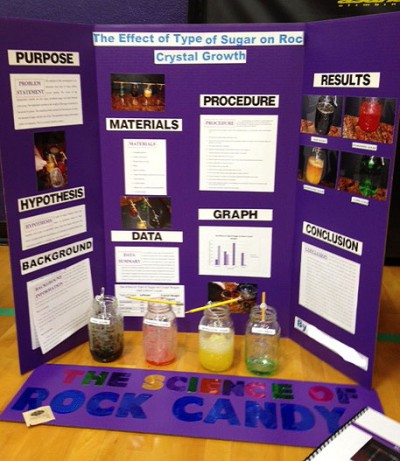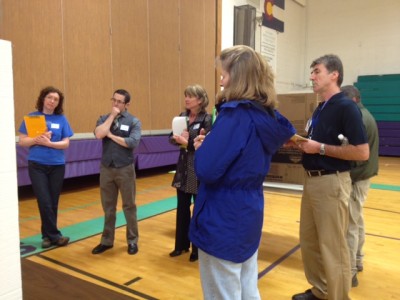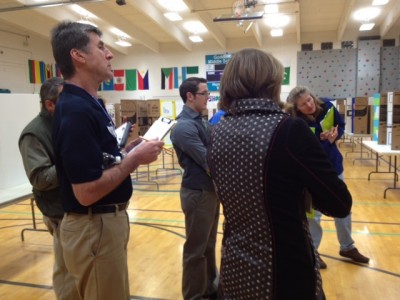A Behind the Scenes Look at Science Fair Judging
A few weeks ago, I was asked to be a judge at a local middle school’s 8th grade science fair. I was so excited to volunteer to take on title of Science Fair Judge for the first time.
I had no idea what to really expect or how to perform my judging duties as I drove to the school that morning.
This science fair consisted of honor science students’ projects. The two science teachers picked the top 20 projects out of their classes for the judges to interview, but the gym was full of project boards.
Before we began, I really enjoyed wandering around and looking at all of the projects. There were so many creative and unique ideas and all of the kids did a great job. I was glad we didn’t have to narrow the field based on the boards. That was a tough decision.
 Judges were given sample questions, a few instructions and were then broken into groups of three to interview students about their projects.
Judges were given sample questions, a few instructions and were then broken into groups of three to interview students about their projects.
As we waited on the floor of the gym, I was nervous. I didn’t want to appear like I didn’t know what I was doing, but I also didn’t want to intimidate the students and grill them. I wondered if the kids could smell the fear on me, these were middle school students afterall.
Our first student came down and we began asking him questions. The poor boy was so nervous and jittery that it was hard to really follow his complicated project on bone densities. I could tell he had done a lot of research and a lot of work. I wanted to ask him to start over and explain it to me, as I was obviously not as smart as he and wasn’t following. But I didn’t want to make him more nervous, so I just listened and tried to put an intelligent, but kind look on my face. I wanted to hug him and tell him if he knew me, he’d know I was nothing to be nervous about.
I thought about what I was like when I was in 8th grade and wasn’t sure I’d be able to stand up to the pressure of talking to three adults while they grilled me about my project.
The first interview was tough, because we didn’t have anything to compare it to. All of the judges had little or no science fair judging experience, so we were all finding our way through.
We spent the next few hours taking turns interviewing students as they came down. Some were more nervous than others and some were more informed and prepared than others. I began getting a stronger sense of understanding what truly made a good project and scientist.
The actual topic of the project had very little to do with the success of a student. Here is what defined a science fair contender, some are obvious:
- Clarity – Thoroughly researched and well thought out projects with a strong understanding of the scope, vocabulary and background
- Complete understanding and use of independent and dependent variables
- Scientific Thought – Hypothesis tested in investigation and research led to valid hypothesis
- Controlled Data – Consistent experiment environment
- Presentation – Clear and concise project boards
- Thoroughness and Skill – Possible sources of error and understanding what they needed to do differently next time
- Strong public speaking skills
- Creativity and originality

During lunch, the judges came together and chose the top seven students and their projects that we believed fully met all of the criteria listed above. Those seven students had to come back that afternoon and re-interview with all eight judges. I never would have made it.
After we completed our final round of interviews, we chose the top three who were honored in a ceremony that night and won a gift card to Barnes and Noble. Not a bad prize after all that work and pressure.
The winner was unanimously chosen by all eight judges. She had stunning presentation skills, understood her project inside and out and didn’t miss a thing. Her project involved testing how dog food is broken down in the stomach and which one is best to feed your dog. She simulated a dog stomach with lemon juice and water and let dog food pieces dissolve for a set time to see which one worked the best. We had to ask her definitions for some of the terms she used, because some of it went over our heads. She knew exactly how she would do the experiment better next time – use a balloon to better simulate a stomach with motion and digesting. Wow. Nothing like being blown over by an eighth grader.
Looking for a great science fair experiment, here are the top seven projects that won –
- Which dog food is the most nutritious?
- The 5 Second Rule with Cucumbers – Can food pick up germs after hitting the floor for 5 seconds, 1 minute, 1 hour?
- Which ski jacket keeps you warmest in cold weather?
- Which green material keeps your house coolest in summer? Using bird houses and wheat grass.
- Music to My Feet – the effect of positive music on energy burned while exercising.
- Phantom pain – can you correctly identify touch sensations when you can’t see it?
- Bacteria Growth – does soap or hand sanitizer work better to kill germs?





I was reading your blog post, and couldn’t agree more with your experience. I am a college student and pursuing a degree in Elementary Education. This semester in my Science Methods class we were to judge at two different science fairs. This was a new experience for me as I was always the one being judged when I was in Elementary. I was very nervous as well when I walked into the gym for the first time. I could see the fear in some of the students faces when they noticed the judges were there and ready to drill them with questions.
I enjoyed also reading about the different project titles that you came across. I noticed some very interesting topics as well, a few being..
1. Is Money Magnetic?
2. Solar Ovens
3. Is it possible to cook an egg on the sidewalk?
4. Net or No Net?-Does a hoop with no net effect your shooting average.
There were many more along with the few I listed. I was very impressed with all the different topics along with the knowledge that the students were able to show when answering questions. Although I may have been super nervous to judge the students but I would gladly judge a fair again, it’s a great experience I believe everyone should take part in!
Again, I really enjoyed reading your post.
Teri – thank you so much for your comments. I’m glad I’m not alone. I really enjoyed judging and hope I can do more in the future. I like your science fair topics. My daughter and I built solar ovens a few years ago as a project. We had different designs and tested which one would melt chocolate faster.